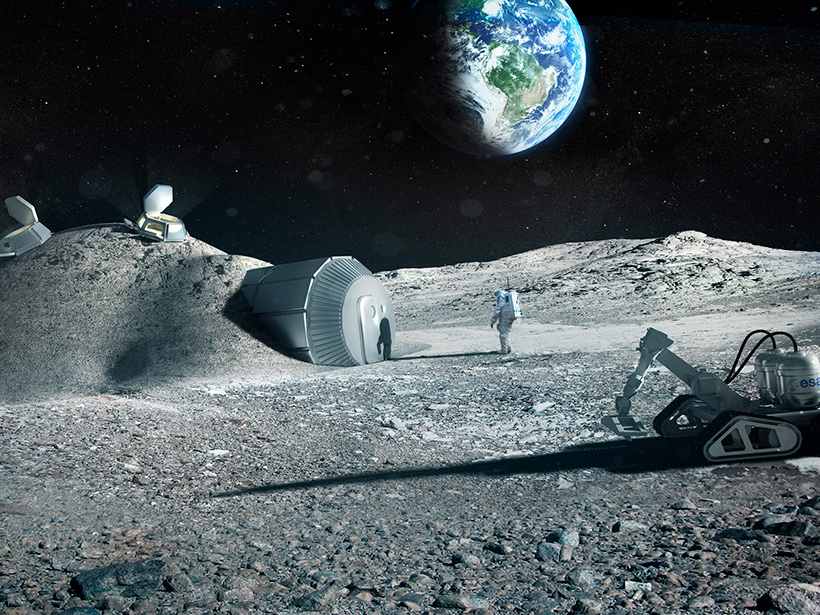Moon colonists may one day need to build shelters or other structures to create a lunar settlement. But the weight and bulk of building materials make importing them from Earth impractical. Moreover, the soil on the Moon holds together too poorly for making walls. A team of researchers from Germany may now have found a way around these difficulties: printing bricks and other structures from local materials using sunlight.
Using their solar-powered, three-dimensional (3-D) printer, Alexandre Meurisse, an engineer at the German Aerospace Centre in Cologne, and his colleagues demonstrated in the laboratory that they could manufacture a solid brick from a material that simulates lunar regolith—the layer of dust, soil, and broken rock on the Moon’s surface.
Meurisse described the experiment on 18 May at the European Lunar Symposium in Amsterdam, Netherlands.
Other researchers have made building materials from regolith in the past but not using a 3-D printer that operates on sunlight alone, Meurisse said. The European Space Agency (ESA), which funded this brick-making effort, has researched for years the possibility of building a lunar base using 3-D printers. The new solar technology offers an alternative to microwave 3-D printing—a way that NASA has explored for making Moon structures.
Creating a Moon Brick

To make a brick, the researchers placed a thin layer of regolith on a mechanical table that can move in three perpendicular directions and slowly passed the layer through a focused beam of sunlight that can heat a morsel of regolith to 1100°C, Meurisse said. Wherever the beam hits, it sinters the soil, solidifying it. When one layer is complete, the engineers then deposit a new layer of loose regolith on top and sinter it, which also adheres it to the underlying surface.
Making one brick takes approximately 2 hours. “But the brick is merely a model, a proof of the concept,” Meurisse told Eos. In line with prior ESA research about 3-D printing on the Moon, Meurisse and his colleagues anticipate lunar pioneers using the new sintering method to produce much larger objects with more complicated shapes, maybe even “a full habitat.” “We won’t ask the astronauts to pile up bricks,” he said.
Products of the technique could also find use in roads, launchpads, and shelters that protect occupants from cosmic rays and meteorites, Meurisse added.
A Moon Village?
Although neither ESA nor NASA is currently preparing for a manned mission to the Moon, ESA is pondering a Moon Village for robotic and human missions, so a lunar regolith 3-D printer might prove useful. ESA has identified potential sites for such a village at the Moon’s south pole near the Shackleton crater, where the Sun continuously illuminates areas over several months.
Should an eventual lunar mission select the new printing technology, its developers would need to adapt their invention to the reality of lunar travel and settlement, Meurisse explained. Not only is the prototype device way too big, but also the researchers have tested it only in a lab here on Earth with its terrestrial atmosphere, gravity, and other conditions. What’s more, the researchers have yet to try out their method on actual lunar soil.
Lunar Regolith Simulants
Moon rocks are scarce here on Earth. NASA watches over these rocks and decides who can use them for approved scientific purposes. These don’t include designing building materials—that would require simply too much rock. Therefore, Meurisse and his coworkers used simulated Moon rock—an Earth-made material that closely resembles the regolith of the Moon.
“There are a considerable number of lunar soil simulants that have been made wrongly and used for the wrong studies.”
In another presentation at the 18–19 May European Lunar Symposium, Lawrence Taylor, a lunar scientist and expert on regolith simulants at the Planetary Geoscience Institute of the University of Tennessee in Knoxville, raised concerns about those substitute materials. “There are a considerable number of lunar soil simulants that have been made wrongly and used for the wrong studies,” he said in his 18 May talk.
In scientific experiments, lunar simulants don’t need to match up perfectly with the composition of actual lunar soil, but scientists need to select simulants with physical, chemical, or mineralogical properties appropriate to the research being conducted, Taylor said. As an example, Taylor alluded to simulant JSC-1, which was developed in 1994 for its geotechnical properties alone but has been used in experiments that depend on other regolith properties. “It was even used to study the hydrogen reduction of ilmenite—a means of obtaining oxygen” on the Moon, Taylor told Eos. “Yet there is no ilmenite in this simulant.”
Meurisse says he is aware of this issue. To make their brick, he and his collaborators used a simulant that has a mineral composition and glass content as close as could be found to those of real lunar regolith. Whether these are really the characteristics most important to sintering behavior has yet to be verified, however, so the team is also testing simulants from all over the world to determine which simulant qualities must match those of real regolith.
Future Simulants for Other Worlds
In a paper about the simulated regolith last month, Taylor argued for more communication between lunar scientists and engineers to ensure that all experiments have lunar relevance. In addition, he advocated establishing an “Office of Space Simulants” within the lunar curatorial office at the Johnson Space Center in Houston, Texas. The need for careful oversight of simulants will only grow, Taylor said, “as samples are returned and curated from new heavenly bodies, like, for example, the planet Mars and the asteroid Bennu.”
—Marlies ter Voorde, Freelance Science Journalist; email: [email protected]
Citation:
ter Voorde, M. (2016), Could 3-D printers create shelters for future lunar settlers?, Eos, 97, https://doi.org/10.1029/2016EO053239. Published on 31 May 2016.
Text © 2016. The authors. CC BY-NC-ND 3.0
Except where otherwise noted, images are subject to copyright. Any reuse without express permission from the copyright owner is prohibited.

